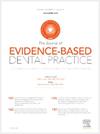THE EFFECT OF DIFFERENT SURFACE MODIFICATIONS ON THE OSSEOINTEGRATION OF DENTAL IMPLANT UNDER DIABETIC CONDITIONS: A SYSTEMATIC REVIEW AND META-ANALYSIS OF IN VITRO RESEARCH
IF 4
4区 医学
Q1 DENTISTRY, ORAL SURGERY & MEDICINE
引用次数: 0
Abstract
Background
Osseointegration, the direct connection between bone and implant, is crucial for dental implant success, particularly in patients with diabetes mellitus (DM) where impaired bone healing poses a challenge. Surface modifications of dental implants have emerged as an effective strategy to enhance osseointegration in such compromised conditions. This systematic review aimed to evaluate the impact of various surface modifications on the osseointegration of dental implants under diabetic conditions, with a focus on alkaline phosphatase (ALP) activity, osteopontin (OPN) and osteocalcin (OCN) as markers of osteogenic potential.
Methods
This review was conducted following PRISMA guidelines and included studies assessing surface modifications on dental implants in diabetic models. A comprehensive literature search was performed across PubMed, Embase, and Web of Science up to July 2024. Inclusion criteria focused on studies that incorporated in vitro experiments with quantitative measurements of bone formation. Data extraction and quality assessment were performed on eight selected studies. Statistical analysis included the calculation of Response Ratios (RR) for ALP activity, and meta-analyses of OCN and OPN expression levels measured at certain time point. The pooled results were visualized using forest plots.
Results
The included studies demonstrated a consistent increase in ALP activity across surface-modified implants, particularly at 7 and 14 days postimplantation. The 7-day RR was 2.02 (95% CI: 1.76-2.29), and the 14-day RR was 1.36 (95% CI: 1.18-1.55), indicating enhanced osteogenic potential. Similarly, OCN expression at day 7 showed a significant pooled standardized mean difference (SMD) of 11.01 (95% CI: 3.02-19.00), and OPN expression at day 7 demonstrated a more consistent effect, with a pooled SMD of 3.76 (95% CI: 2.46-5.06), all suggesting a marked upregulation of osteogenic differentiation markers. However, significant heterogeneity was observed, attributed primarily to differences in cell lines and experimental conditions.
Conclusion
Surface modifications significantly enhance osseointegration of dental implants in diabetic conditions, as evidenced by increased ALP activity and elevated expression levels of key osteogenic markers such as OCN and OPN. Despite the promising results, future research should address the heterogeneity by standardizing methodologies and expanding the number of included studies to refine these techniques and their clinical applicability.
不同表面修饰对糖尿病牙种植体骨整合的影响:体外研究的系统回顾和荟萃分析
背景骨和种植体之间的直接连接,对于种植体的成功至关重要,特别是对于患有糖尿病(DM)的患者,骨愈合受损是一个挑战。牙种植体的表面修饰已成为一种有效的策略,以加强骨整合在这样的妥协条件。本系统综述旨在评估各种表面修饰对糖尿病牙种植体骨整合的影响,重点关注碱性磷酸酶(ALP)活性、骨桥蛋白(OPN)和骨钙素(OCN)作为成骨潜能的标志物。方法本综述遵循PRISMA指南,包括评估糖尿病模型种植体表面修饰的研究。到2024年7月,在PubMed、Embase和Web of Science上进行了全面的文献检索。纳入标准侧重于结合体外实验和骨形成定量测量的研究。对选定的8项研究进行数据提取和质量评估。统计分析包括计算ALP活性的反应比(RR),以及在特定时间点测量OCN和OPN表达水平的meta分析。汇总结果使用森林样地可视化。结果纳入的研究表明,ALP活性在表面修饰的种植体中持续增加,特别是在种植后7天和14天。7天的RR为2.02 (95% CI: 1.76-2.29), 14天的RR为1.36 (95% CI: 1.18-1.55),表明成骨潜能增强。同样,第7天的OCN表达显示出显著的合并标准化平均差异(SMD)为11.01 (95% CI: 3.02-19.00),第7天的OPN表达表现出更一致的效果,合并SMD为3.76 (95% CI: 2.46-5.06),所有这些都表明成骨分化标志物的显著上调。然而,观察到显著的异质性,主要归因于细胞系和实验条件的差异。结论表面修饰可显著促进糖尿病患者种植体的骨整合,其表现为ALP活性升高,OCN和OPN等关键成骨标志物表达水平升高。尽管结果令人鼓舞,但未来的研究应通过标准化方法和扩大纳入研究的数量来解决异质性问题,以完善这些技术及其临床适用性。
本文章由计算机程序翻译,如有差异,请以英文原文为准。
求助全文
约1分钟内获得全文
求助全文
来源期刊

Journal of Evidence-Based Dental Practice
DENTISTRY, ORAL SURGERY & MEDICINE-
CiteScore
6.00
自引率
16.70%
发文量
105
审稿时长
28 days
期刊介绍:
The Journal of Evidence-Based Dental Practice presents timely original articles, as well as reviews of articles on the results and outcomes of clinical procedures and treatment. The Journal advocates the use or rejection of a procedure based on solid, clinical evidence found in literature. The Journal''s dynamic operating principles are explicitness in process and objectives, publication of the highest-quality reviews and original articles, and an emphasis on objectivity.
 求助内容:
求助内容: 应助结果提醒方式:
应助结果提醒方式:


